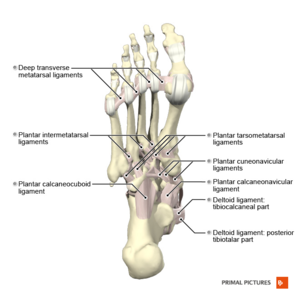Cuboid
Original Editor - User Name Top Contributors - Mahbubur Rahman, Alex Benham, Rucha Gadgil and Kim Jackson
Description[edit | edit source]
The cuboid is one of the seven bones which make up the tarsus of the Ankle and Foot and it is one of the five bones of the midfoot. It is located on the lateral aspect of the foot, anterior to the calcaneus, next to the navicular and lateral cuneiform bones, and posterior to the 4th and 5th metatarsal. [1].
Structure[edit | edit source]
It is a small, irregular-shaped bone, approximately cubical in shape where is derives its name. The small bone contains many smooth facets to allow articulation with the calcaneus posterioly, the cuneiform and navicular medially and the 4th and 5th metatarsals anteriorly. On the inferior aspect of the bone, there is a small bony prominence named the cuboid tuberosity and a sulcus stretching obliquely in an anteromedial direction called the peroneal sulcus, holding in place the tendon of the peroneus longus. Its shape and location mean that it plays a strong role in maintaining the lateral longitudinal arch of the foot in addition to some of the role of the transverse arch along with the cuneiform bones.
Function[edit | edit source]
The cuboid helps provide for the stability of the foot and the movement of the toes, in addition to ensuring proper weight distribution and flexibility along the plantar fascia that runs along the sole of the foot.
Muscle and ligamentous attachments[edit | edit source]
The only muscular attachment to the cuboid bone is a plantar branch of the tibialis posterior [5]
For its size, there are a large number of ligaments that attach to the cuboid due to its role in direct weightbearing. These are...
Dorsal and Plantar Calcaneocuboid ligaments
Birfurcate ligament (calcaneocuboid portion)
Cuboideonavicular ligament
Dorsal, plantar interosseous cuneocuboid ligaments
Clinical relevance[edit | edit source]
Fractures of the bone on its own are rare and so if fractures do occur, these are often alongside more widespread trauma [6]. Damage to the area of the cuboid is noted to be involved with a Lisfranc injury where the metatarsal bones are displaced from the tarsus [7]. The main related pathology is Cuboid Syndrome [8]
References[edit | edit source]
- ↑ Soames RW. Anatomy and Human Movement E-Book: Structure and function. Elsevier Health Sciences; 2018 Aug 22.
- ↑ https://commons.wikimedia.org/wiki/File:Cuboid_bone_05_inferior_view.png
- ↑ https://commons.wikimedia.org/wiki/File:Cuboid_bone_05_inferior_view.png
- ↑ https://commons.wikimedia.org/wiki/File:Cuboid_bone_05_inferior_view.png
- ↑ Bubra, Preet Singh, Geffrey Keighley, Shruti Rateesh, and David Carmody. "Posterior tibial tendon dysfunction: an overlooked cause of foot deformity." Journal of family medicine and primary care 4, no. 1 (2015): 26.
- ↑ Angoules, Antonios G., Nikolaos A. Angoules, Michalis Georgoudis, and Stylianos Kapetanakis. "Update on diagnosis and management of cuboid fractures." World journal of orthopedics 10, no. 2 (2019): 71.
- ↑ Moracia-Ochagavía, Inmaculada, and E. Carlos Rodríguez-Merchán. "Lisfranc fracture-dislocations: current management." EFORT open reviews 4, no. 7 (2019): 430-444.
- ↑ Patterson, Stephen M. "Cuboid syndrome: a review of the literature." Journal of sports science & medicine 5, no. 4 (2006): 597.







